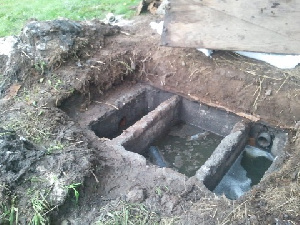Opinions of Wednesday, 18 October 2017
Columnist: S. Rodney Coleman
Septic tank systems: Major source of emerging contaminants in drinking water
Waterborne diseases have a great burden on both public health and the economy.
Globally, 4 billion cases of diarrhea occur annually, out of which around 2 million people die. In developing countries like Ghana, nearly 80% of all diseases are linked to water and sanitation; and children bear the greatest health burden.
Throughout history there have been many occasions when hundreds of thousands of people have fallen sick and many left dead because, disease-causing germs have been spread through a community by a contaminated water supply.
Despite access to adequate amounts of clean water being crucial to human health and development, there are still some 700 million people worldwide without access to improved sources of drinking water.
Currently, Ghana’s performance in the delivery of selected water and sanitation services (like access to pipe-borne water) is poor as compared to other middle-income countries.
In spite of the immeasurable human dependence on clean water, fresh water resources in Ghana are concurrently coming under increasing pressure from factors such as pollution, rapid population growth and climate change.
Contamination of drinking water supplies by septic tank system
Recent studies in Ghana and elsewhere have shown an emerging trend suggesting that, septic tank systems routinely discharge pathogens, pharmaceuticals, consumer product chemicals, and other potentially hazardous chemicals into the environment.
Once discharged, these end up in groundwater and drinking water supplies, raising health problems. The concentrations of these contaminants are usually found to exceed the World Health Organisation permissible limit for drinking water and other domestic needs.
While a properly constructed, situated and maintained septic tank does not pose environmental and health problems, certain problems can arise from unstandardized tank system.
They include odour and gas emissions; excess nutrients seepage into waterbodies; groundwater and surface water pollution.

How can I lend a helping hand as a CITIZEN?
1. When in need of a new septic tank, an expert should be sought to design and construct it, following the EPA guidelines.
2. All septic tanks must be 30m away, or more, from water sources such as boreholes, wells, and drinking water supplies.
3. Septic tanks should be inspected regularly for a timely detection of any anomaly.
4. Older septic tanks usually require more frequent emptying times if the number of users have increased.
5. Water drawn from hand-dug wells and shallow boreholes situated near a septic system may need proper treatment before use.
6. Excessive disposal of substances such as cooking oils and grease can cause the inlet drains to block. These are often difficult to degrade and can cause odour problems and difficulties with the emptying of tanks.
7. Flushing non-biodegradable waste items down the toilet (such as cigarette butts, cotton buds/swabs or menstrual hygiene products and condoms) can cause a septic tank to clog and fill-up quickly.
8. Using the toilet for disposal of food waste can cause a rapid overload of the system with solids and contribute to failure.
9. Certain chemicals and inorganic materials may damage the components of a septic tank or kill the bacteria needed in the septic tank for the system to operate properly. Such chemicals include pesticides, herbicides, medicines, disinfectants and paints.
10. Watch out for trees and shrubs. Roots from plants protruding above the tank or drainfield may clog and/or break the tank. Trees that are directly within the vicinity of a concrete septic tank have the potential to penetrate the tank as the tank ages and the concrete begins to develop cracks and small leaks. Tree roots can cause serious flow problems due to plugging and blockage of drain pipes.
11. Excessive run-off water from rains entering the tank can overload it and cause its untimely destruction. Create water-paths for excess run-offs.
12. Any septic tank suspected to be functioning improperly or damaged should be repaired immediately.
13. Reporting a septic tank owner who disregards the need to keep a properly working septic tank to the authorities (the EPA or Metropolitan/Municipal/District assemblies) is recommended.
Waterborne diseases have a great burden on both public health and economy; they place a heavy burden on the entire population. Every necessary helpful intervention must therefore be supported by all and sundry.
Entertainment










